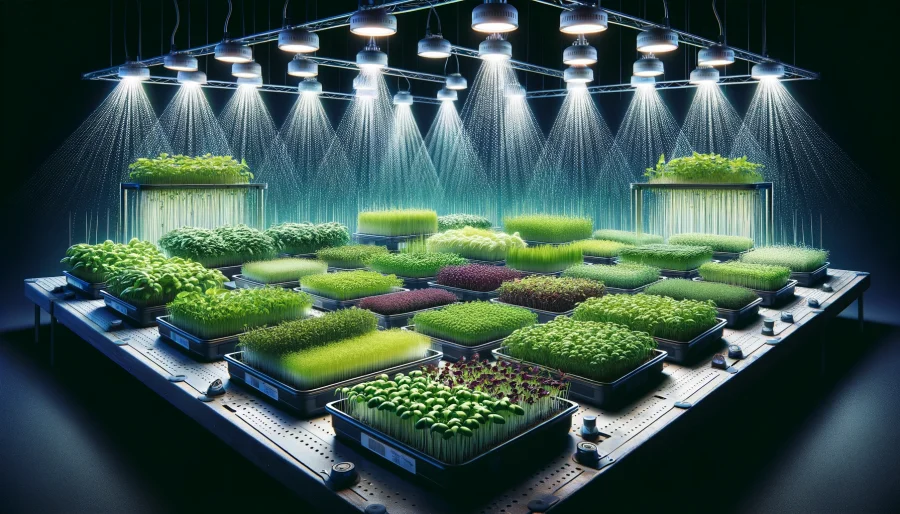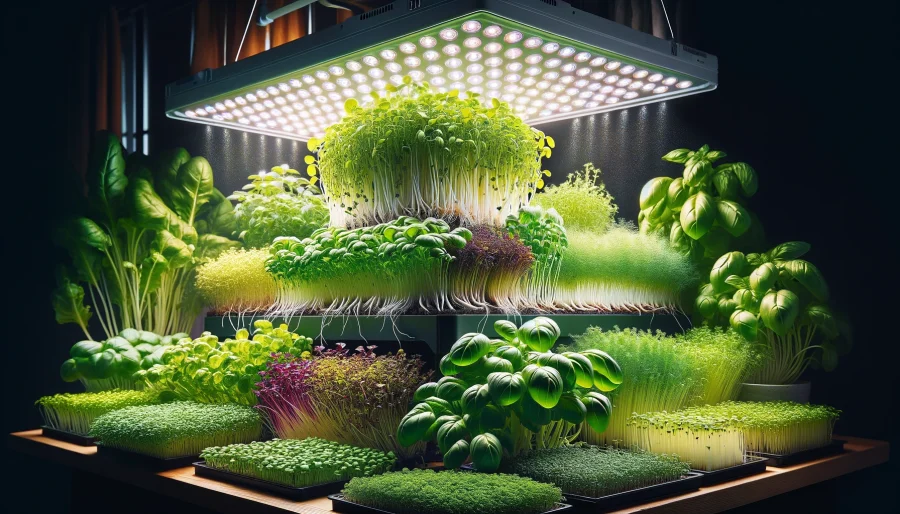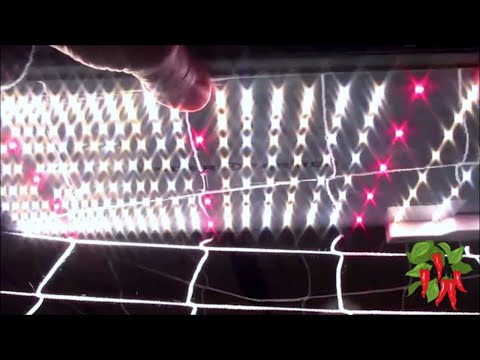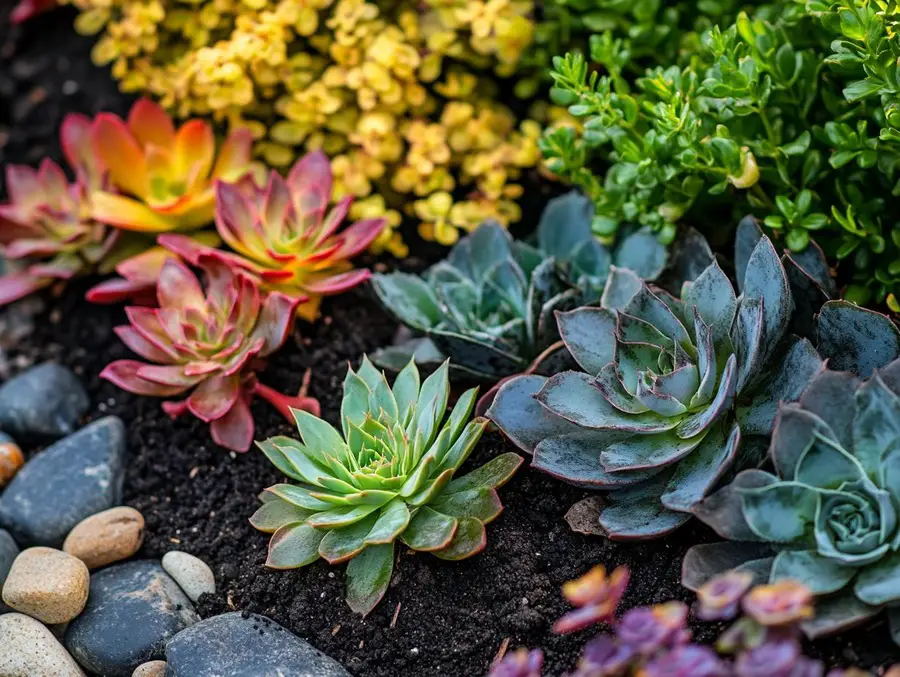We use affiliate links. If you purchase something using one of these links, we may receive compensation or commission.

Discover how much light do microgreens need for lush growth. Get tips on optimal lighting for vibrant, nutritious greens in our friendly guide.
How Much Light Do Microgreens Need?
Key Takeaways:
- How much light do microgreens need?
- Microgreens require 12-16 hours of light daily to ensure optimal growth and development.
- Adequate light is crucial for photosynthesis, promoting healthy, vibrant greens.
- Utilize full-spectrum LED lights for the best results, mimicking natural sunlight conditions.
Want to know how much light microgreens need to flourish? You’re in the right spot!
Whether you’re a seasoned gardener or just starting out, understanding the light needs of microgreens is key to growing these nutrient-packed greens.
From sunlight to LED lights, we’ll cover everything you need to know to ensure your microgreens grow vibrant and strong. Let’s dive into the world of microgreens and light!
What You’ll Learn
Are you curious about the world of microgreens and how to grow them successfully?
One essential factor to consider is the amount of light they require.
In this article, we will explore what microgreens are, the different types available, and the optimal light conditions needed for their growth.
We will also discuss the effects of insufficient or excessive light on microgreens, as well as ways to provide adequate light using natural or artificial sources.
Stay tuned to learn more about the best light sources and exposure times for your microgreens at each growth stage.
What Are Microgreens?
Microgreens are young vegetable greens that are approximately 1-3 inches tall and are harvested just after the first leaves have developed.
These miniature plants are in a growth stage between sprouts and baby greens, typically ready for harvest within 7-21 days.
Their small size and intense flavors and vivid colors make them a popular choice among chefs for enhancing dishes.
Rich in nutrients, including vitamins, minerals, and antioxidants, microgreens are also known sources of chlorophyll, contributing to their vibrant green hues.
Microgreens are vegetable greens (not to be confused with sprouts or shoots) harvested just after the cotyledon leaves have developed with one set of true leaves. They are used as a visual, flavor and texture enhancement. Microgreens are used to add sweetness and spiciness to foods. Microgreens are smaller than “baby greens” because they are harvested soon after sprouting, rather than after the plant has matured to produce multiple leaves. Wikipedia
What Are the Different Types of Microgreens?
Microgreens encompass a wide variety of plant species, each offering unique flavors, textures, and nutritional benefits.
Popular types of microgreens include arugula, basil, kale, and radish, each providing a distinct taste profile; arugula with its peppery kick, basil’s subtle sweetness, kale’s earthy notes, and radish’s mild spice.
These tiny greens pack a powerful nutritional punch, rich in vitamins like A, C, and K, essential minerals such as potassium and iron, and vibrant antioxidants like beta-carotene and lutein.
Incorporating a colorful array of microgreens into your salads, sandwiches, and smoothies can not only enhance the visual appeal but also boost the overall nutrient content of your meals.
Did you know you can grow microgreens without soil?
How Much Light Do Microgreens Need?

Proper light exposure is crucial for the healthy growth and development of microgreens, influencing essential processes like photosynthesis and chlorophyll production.
Light serves as the primary energy source for microgreens, driving the photosynthesis process that converts light energy into chemical energy.
Different wavelengths within the light spectrum play a crucial role in plant growth and development.
For instance, blue light stimulates chlorophyll synthesis, influencing leaf development and overall plant health.
The intensity of light can be measured in lux or lumens but PAR (photosynthetically active radiation) is used for LED lights and is equally important.
Insufficient light and growing microgreens in low light conditions can lead to weak, leggy stems and pale leaves in microgreens.
To ensure optimal growth, providing a balanced spectrum of light with adequate intensity is key.
What Are the Optimal Light Conditions for Microgreens?
Microgreens thrive under specific light conditions, with optimal wavelengths, intensity levels, and durations supporting their healthy growth and nutritional content.
When cultivating microgreens, it is essential to provide them with light in the blue and red spectrum, typically around 450-475nm and 640-680nm, respectively.
These wavelengths are crucial for photosynthesis and ensure proper development.
Light intensity, measured in PPF (Photosynthetic Photon Flux), should be around 200-300 μmol/m²/s during the growth stage.
For optimal results, maintain light exposure for 12-16 hours a day, mimicking natural sunlight cycles.
What Are the Effects of Insufficient Light on Microgreens?
Insufficient light exposure can hinder the growth of microgreens, leading to elongated stems, pale leaves, and reduced nutritional value.
When microgreens do not receive adequate light, they tend to exhibit leggy growth, where the stems elongate excessively in an attempt to seek out more light.
This results in weak stems that are unable to support robust leaf growth, compromising the overall strength and structure of the plant.
The lack of sufficient light can lead to decreased chlorophyll production, contributing to the paleness of the leaves and a reduction in the vital nutrients that these plants are meant to provide.
What Are the Effects of Too Much Light on Microgreens?
Excessive light exposure can also be detrimental to microgreens, causing leaf scorching, stunted growth, and nutrient imbalances.
When microgreens receive too much light, their delicate leaves can easily get sunburnt, leading to irreversible damage and affecting the overall aesthetic appeal of the plants.
The stress induced by excessive light can hinder their growth rates, resulting in smaller and less vibrant microgreens.
The imbalance in nutrient uptake caused by prolonged exposure to intense light can disrupt the plants’ development and compromise their nutritional value.
To regulate the light intensity and prevent these issues, growers can strategically adjust the placement of grow lights, use light diffusers or shades to scatter light more evenly, and implement light timers to ensure consistent exposure levels.
By carefully managing the light environment, microgreens can thrive and develop properly, yielding high-quality harvests.
Can Microgreens Grow Without Light?
Microgreens cannot thrive without adequate light, as they depend on light energy for photosynthesis, growth, and nutrient synthesis.
Light plays a crucial role in the life cycle of microgreens, serving as the primary source of energy for the photosynthetic process.
Through photosynthesis, microgreens convert light into essential nutrients, such as carbohydrates and proteins, which are vital for their growth and development.
Light influences the production of pigments and flavor compounds in microgreens, contributing to their nutritional quality and taste.
Growing microgreens in low-light environments pose significant challenges.
Insufficient light can lead to stunted growth, pale leaves, and poor nutritional content in microgreens.
Without optimal light levels, microgreens may struggle to generate enough energy for their metabolic processes, affecting their overall health and yield.
How to Provide Adequate Light for Microgreens?
Ensuring adequate light for microgreens involves utilizing suitable light sources like LED grow lights to provide the necessary spectrum, intensity, and duration for optimal growth.
LED grow lights have become a popular choice for indoor cultivation due to their energy efficiency and customizable features.
To maximize growth, it is essential to have a white light spectrum based on the specific needs of the microgreens.
White light is not really white but includes the full spectrum of light microgreens require.
Different wavelengths of light impact plant growth in various ways, influencing factors such as leaf development and nutrient uptake.
By understanding how different spectra affect plant metabolism, growers can use white light full spectrum LED grow lights to enhance the overall quality of their crops.
Natural Light
Natural sunlight is an excellent source of light for microgreens, offering a broad spectrum of wavelengths necessary for robust growth and development.
One of the key benefits of harnessing natural light for indoor microgreen cultivation is its ability to provide a full spectrum of wavelengths that mimic the sun’s natural cycle.
This comprehensive range of light not only supports photosynthesis but also contributes to the production of essential nutrients, resulting in healthier and more flavorful microgreens.
By utilizing sunlight, microgreens receive the optimal balance of red, blue, and green light that is crucial for their development.
This natural source of light helps regulate plant processes, enhance flavor profiles, and increase the nutritional content of the harvested greens.
Exposing microgreens to natural sunlight can lead to higher yields and more vibrant colors, making them not only visually appealing but also nutritionally dense.
Artificial Light
Artificial lighting, especially LED grow lights, provides a tailored spectrum of light that can meet the specific requirements of microgreens at different growth stages.
LED grow lights offer significant advantages for indoor microgreen cultivation due to their full light spectrum, intensity, and duration, mimicking the natural sunlight conditions needed for optimal plant growth.
With LEDs, growers can adjust the light height based on the developmental stages of microgreens, ensuring they receive the appropriate light wavelengths required for photosynthesis and overall health.
LED lights enable growers to fine-tune the lighting conditions for different types of microgreens, promoting higher yields and better-quality crops.
By controlling the intensity and duration of light exposure, LED grow lights facilitate energy-efficient cultivation, reducing electricity costs while maximizing plant productivity.
What Are the Best Light Sources for Microgreens?
When selecting light sources for microgreens, LED lights, and fluorescents are popular choices due to their energy efficiency, customizable spectra, and consistent performance.
LED lights have gained significant popularity in recent years for indoor growing applications, including microgreens cultivation.
One of the key advantages of LED lights over fluorescents is their superior energy efficiency, leading to lower electricity bills and reduced environmental impact.
LED lights offer a more tailored light spectrum, allowing growers the light color and intensity to meet the specific needs of different plant growth stages.
This enhances the overall growth and quality of microgreens, resulting in higher yields and better nutritional content.
Fluorescent Lights
Fluorescent lights are a cost-effective option for providing steady illumination to microgreens, offering sufficient lumens and kelvins for healthy plant growth.
One of the key advantages of using fluorescent lights for microgreens is their consistent brightness levels, which are essential for promoting photosynthesis and overall plant development.
With a color temperature that closely mimics natural sunlight, these lights provide the necessary spectrum of light for optimal growth, particularly in the blue and red nanometers range.
This balanced light color spectrum is crucial for encouraging robust leafy growth and enhancing the flavor profile of the harvested microgreens.
Fluorescent lights are highly efficient in converting energy into light, making them an eco-friendly choice for indoor gardening enthusiasts.
LED Lights

LED lights are increasingly popular for microgreen cultivation due to their high efficiency, targeted light output, and ability to provide the necessary photosynthetic photon flux (PPF) for plant growth.
One key advantage of using LED lights is their exceptional energy efficiency, which results in lower electricity bills for growers and reduced environmental impact.
Some LED lights offer a customizable spectrum that can be tailored to meet the specific light requirements of different microgreen varieties, promoting optimal growth and yield.
LED lights emit light in a targeted manner, ensuring that a high percentage of the light produced is absorbed by the plants, thereby maximizing photosynthesis and overall plant health.
This targeted light delivery also contributes to the overall efficiency of the growing process, as less light is wasted.
Incandescent Lights
While incandescent lights can provide warmth, they are less suitable for microgreens due to their lower light intensity and inefficient energy use compared to LED or fluorescent options.
Incandescent lights have limited utility when it comes to cultivating microgreens due to several reasons.
Their lower light intensity means that microgreens may not receive enough light for optimal growth, leading to leggy and weak plants.
They don’t produce a good spectrum of light for plants so I would not try to grow microgreens or any other plants with them.
Incandescent lights tend to produce more heat than LED or fluorescent lights, which can be damaging to the delicate microgreens, especially in a confined space.
Their energy inefficiency results in higher electricity bills and shorter lifespans, making them a less cost-effective choice in the long run.
How Long Should Microgreens Be Exposed to Light?
The duration of light exposure plays a critical role in the growth and development of microgreens, impacting their germination, growth stages, and eventual harvest quality.
During the germination stage, microgreens typically need around 12-16 hours of light per day for optimal growth.
This helps in stimulating the initial sprouting process and promoting strong root development.
As the microgreens progress into the growth phase, maintaining a consistent light exposure of around 14-18 hours per day is recommended to ensure robust leaf development and overall vitality.
As microgreens approach the harvesting stage, adjusting the light duration to slightly lower levels, such as 10-12 hours per day, can enhance flavors and nutritional content.
Light duration directly affects chlorophyll production, which impacts the taste and color intensity of microgreens.
Sufficient light exposure is crucial for photosynthesis, ensuring that the plants receive the energy needed for proper growth and nutrient uptake.
Germination Stage
During the germination stage, microgreens require consistent light exposure to support seedling development and ensure proper establishment before true leaf growth begins.
Light plays a crucial role in the germination process of microgreens, acting as a catalyst for photosynthesis and essential growth processes.
Microgreens need ample light to kickstart their growth and establish healthy root systems.
Insufficient light can result in leggy, weak seedlings that struggle to thrive.
It is important to provide the right balance of light intensity and duration, as excessive light exposure can also hinder proper development.
Optimal light conditions can vary depending on the type of microgreen, so it’s essential to research the specific requirements of each variety to ensure successful germination.
Growth Stage
In the growth stage, microgreens benefit from extended light exposure to support photosynthesis, nutrient absorption, and robust leaf development.
Light plays a crucial role in the early stages of growth for microgreens.
Through the process of photosynthesis, light energy is converted into chemical energy, providing the necessary fuel for the plant’s metabolic processes.
This energy is essential for microgreens to synthesize their own food and grow efficiently.
Prolonged light exposure enhances the microgreens’ ability to uptake essential nutrients from the soil or growing medium.
This nutrient absorption aids in the overall health and development of the plant, ensuring it has access to the necessary building blocks for growth.
The duration of light exposure directly impacts the nutrient content of microgreens.
Extended exposure to light can result in increased levels of certain nutrients, making the microgreens not only visually appealing but also nutritionally dense.
Harvesting Stage
As microgreens approach the harvesting stage, reducing light exposure can enhance flavor development, promote color vibrancy, and improve overall texture.
Adjusting the light duration during the crucial harvesting phase of microgreens plays a significant role in shaping their sensory qualities.
By carefully managing the amount of light they receive, growers have the potential to intensify the flavors, maintain the vividness of hues, and elevate the crispness of the greens.
This fine-tuning of light exposure can lead to a more balanced and appealing sensory experience for consumers, distinguishing the microgreens based on their distinctive taste, appearance, and mouthfeel.
Frequently Asked Questions
How much light do microgreens need?
Microgreens need an average of 12-16 hours of light per day to grow and thrive.
Why is light important for microgreens?
Light is crucial for the growth and development of microgreens as it provides the energy they need for photosynthesis.
What type of light is best for growing microgreens?
Microgreens can be grown under natural sunlight or artificial light, but full-spectrum LED grow lights are recommended for optimal growth.
Can I use regular household lights for growing microgreens?
No, regular household lights do not provide the right spectrum of light for microgreens and may result in leggy or stunted growth.
How close should I place the light source to my microgreens?
The light source should be placed about 6 inches above the top of the microgreens for fluorescent lights to prevent them from reaching for light and becoming leggy.
LED lights should be further away but it depends on the wattage. Most manufacturers will tell you how far away to place their lights
Do microgreens need darkness at any point during their growth?
Yes, microgreens require a period of darkness for proper growth. It is recommended to provide 8 hours of darkness for every 24 hours of light.
How Much Light Do Microgreens Need? Conclusion
In conclusion, understanding the light requirements for microgreens is essential for anyone looking to grow these nutrient-rich plants successfully.
Whether you’re using natural sunlight or opting for artificial LED lights, the right lighting conditions can make a significant difference in the health and yield of your microgreens.
Let’s recap the key points to ensure your microgreens receive the optimal amount of light they need to thrive.
Optimal Light Conditions for Microgreens
To grow healthy microgreens, provide them with 12-16 hours of light per day, using a light source that offers a full spectrum of light. This mimics natural sunlight, promoting strong and vibrant growth.
Balancing Light Intensity and Duration
Maintaining the right balance between light intensity and duration is crucial. Too little light can lead to leggy, underdeveloped greens, while too much light can cause stress and burn the delicate leaves.
The Importance of Light for Photosynthesis
Light is vital for the photosynthesis process, enabling microgreens to convert light energy into the nutrients they need for growth. Ensuring your microgreens have enough light is key to unlocking their nutritional and flavorful potential.
Choosing the Right Light Source
LED grow lights are highly recommended for microgreens due to their efficiency, spectrum, and lower heat output compared to other lighting options.
Adjusting Light as Microgreens Grow
As your microgreens grow, adjust the light source’s height to maintain the optimal distance from the plants, preventing stretching or burning as they develop.
By following these guidelines, you can create an ideal growing environment for your microgreens, leading to a successful harvest of these tasty and nutritious greens.
Related Content
Visit my Amazon Influencer Page for videos and gardening products Grow Your Own Garden







